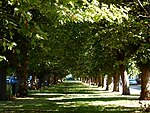Hillingdon Hospital
Buildings and structures in the London Borough of HillingdonEngvarB from October 2017Health in the London Borough of HillingdonHospital buildings completed in 1967Hospitals in Middlesex ... and 2 more
NHS hospitals in LondonResidential buildings completed in 1747

Hillingdon Hospital is an NHS hospital in Pield Heath Road, Hillingdon, Greater London. It is one of two hospitals run by the Hillingdon Hospitals NHS Foundation Trust, the other being Mount Vernon Hospital.
Excerpt from the Wikipedia article Hillingdon Hospital (License: CC BY-SA 3.0, Authors, Images).Hillingdon Hospital
Pield Heath Road, London Hillingdon
Geographical coordinates (GPS) Address External links Nearby Places Show on map
Geographical coordinates (GPS)
| Latitude | Longitude |
|---|---|
| N 51.525833333333 ° | E -0.46111111111111 ° |
Address
Hillingdon Hospital
Pield Heath Road
UB8 3NN London, Hillingdon
England, United Kingdom
Open on Google Maps






